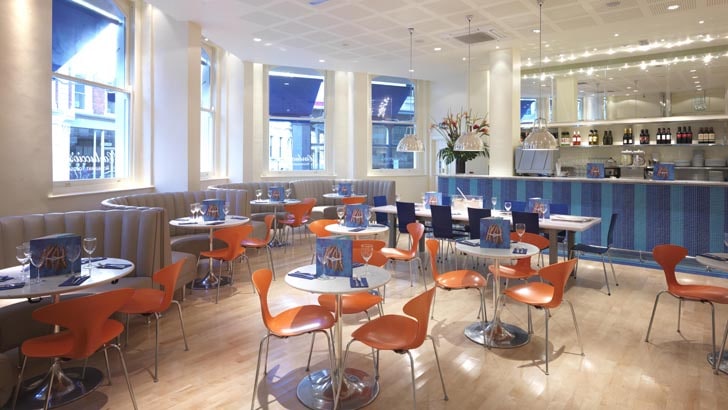
A survey, published in January by Horizons, said that of those who had eaten out recently, one in 10 had done so outside of traditional mealtimes.
From breakfast menus in pubs and restaurants in the UK, to Starbucks’ recent announcement that it plans to serve wine and beer to encourage an evening market, outlets around the world are throwing away the rulebook in an attempt to attract customers and maximise revenue throughout the trading day.
Breakfast: the most important meal of the day
Breakfast is the most popular choice for non-traditional meals out. According to research firm Mintel, US breakfast sales at quick-service and fast food restaurants rose over 5% to $27.4bn last year.
This breakfast offer can vary from a cup of coffee and a snack on the way to work to a sit-down social meal later on in the morning, says Backman.
“What we are noticing is that consumers are changing their habits and taking more meals that aren’t necessarily at lunchtime. People have started taking what they call ‘brunch’.”
While quick-service, fast-casual restaurants and many UK pub chains have managed to successfully implement “a differentiated breakfast menu”, the challenge, says Backman, is for more traditional full-service restaurants to follow suit.
“They have to deliver an attractive offer, both in terms of food and the general ambience. It is more difficult for restaurants to appeal to the breakfast market.”
Backman highlights UK casual-dining restaurant chain Carluccio’s as a brand that has managed to balance an informal all day café atmosphere with quality full-service food provision.
“It’s something Carluccio’s definitely does well,” he says.
Carluccio’s: leading the way
In fact, when it comes to Carluccio’s ability to lead the way in all-day dining, CEO Simon Kossoff would go one step further.
“We invented it,” he says. “When Priscilla Carluccio developed the concept, she thought of it as a daytime operation.
“In her mind this wasn’t just a restaurant for lunch and dinner, it was a place you could come to at any time of day – for breakfast, right through to an early supper.”
At the time, Carluccio was alone in her vision. “Restaurants were for lunch and dinner, and many still are. The idea of having a place like ours and opening at eight in the morning was unusual.”
Capturing the all-day market, says Kossoff, was intrinsic to Carluccio’s success. The chain has opened 27 stores since its launch in 1999. And a fundamental part of its ability to become a truly all-day restaurant was down to its fully flexible dining model.
“We call it no rules for customers. If somebody comes in and wants breakfast at 8 o’clock in the morning they can. If someone wants pasta they can. We’re very happy for you to sit and have a cappuccino while the rest of the restaurant is eating lunch.”
Coffee shops as social spaces: a caffeine boost for informal dining
Since opening in 1999, Kossoff has seen a breakdown in the way his customers approach eating out, something he attributes almost wholly to the explosion in the coffee shop market.
“The coffee shops have created these places where you can hang out, maybe have a coffee or something small, whatever you want. I think that’s responsible for the breakdown in traditional dining.
“We get groups where one person is having a bowl of pasta, one person is having a croissant and one person is having a quick glass of wine because they’re just passing through.”
But, he says, this particular phenomenon is unique to Carluccio’s UK outlets. Although the company’s expansion into Turkey and the Middle East has been met with open-armed enthusiasm, there is still a distinction between coffee shop culture and restaurants.
“People have responded to the brand very well,” he says. “But they’re still just using Carluccio’s as a lunch and dinner spot.”
“That suggests to me that the UK is further ahead on the all-day trend.”
Retail: getting customers in off the street
In addition to being a restaurant, coffee shop and social space, Carluccio’s is also a shop. This offers even more daytime revenue opportunities and, says Kossoff, helps extend the illusion of Carluccio’s as a real daytime outlet.
“The great thing about the shop for us is that you can walk into a Carluccio’s and do a bit of browsing without making any commitments.
“That helps the constant stream of people throughout the day. If they change their mind and decide to sit down and have a bowl of pasta and a glass of wine, then even better.”
The retail model has been picked up in other areas of the restaurant market. Michelin-starred chef Tom Aikens recently introduced Tom’s Kitchen Deli across his expanding Tom’s Kitchen Brand.
The onsite deli, he says, helps maximise revenue coming in throughout the day, at lower expense.
“Sometimes it’s difficult to fill a 50-seat restaurant. But the delis are quicker to develop at much less expense. There’s a really quick turnaround rate. It’s definitely been a very successful model for us so far.”
All day dining is not for everyone. And, says Kossoff, it certainly has its challenges. Not least in managing a rolling shift pattern with staff coming and going throughout the day, rather than the more traditional two-shift structure.
“It took us quite a while at the beginning to really get to grips with managing that. But we got to 27 stores so obviously we learnt something along the way.
It is still early to assess the full impact of all day dining, says Backman. But in his observations of consumer behaviour one thing is certain.
“The number of meals and snacks being bought outside meal times is increasing,” he says. It remains up to the outlets to rise to the challenge and reflect that trend in their offer.
Ellie Clayton
